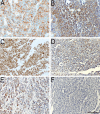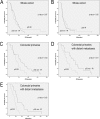Expression of p53 protein in high-grade gastroenteropancreatic neuroendocrine carcinoma
- PMID: 29112960
- PMCID: PMC5675414
- DOI: 10.1371/journal.pone.0187667
Expression of p53 protein in high-grade gastroenteropancreatic neuroendocrine carcinoma
Abstract
Background: Gastroenteropancreatic neuroendocrine carcinomas (GEP-NECs) are aggressive, rapidly proliferating tumors. Therapeutic response to current chemotherapy regimens is usually short lasting. The aim of this study was to examine the expression and potential clinical importance of immunoreactive p53 protein in GEP-NEC.
Materials and methods: Tumor tissues from 124 GEP-NEC patients with locally advanced or metastatic disease treated with platinum-based chemotherapy were collected from Nordic centers and clinical data were obtained from the Nordic NEC register. Tumor proliferation rate and differentiation were re-evaluated. All specimens were immunostained for p53 protein using a commercially available monoclonal antibody. Kaplan-Meier curves and cox regression analyses were used to assess progression-free survival (PFS) and overall survival (OS).
Results: All tumor tissues were immunoreactive for either one or both neuroendocrine biomarkers (chromogranin A and synaptophysin) and Ki67 index was >20% in all cases. p53 immunoreactivity was only shown in 39% of the cases and was not found to be a prognostic marker for the whole cohort. However, p53 immunoreactivity was correlated with shorter PFS in patients with colorectal tumors (HR = 2.1, p = 0.03) in a univariate analysis as well as to poorer PFS (HR = 2.6, p = 0.03) and OS (HR = 3.4, p = 0.02) in patients with colorectal tumors with distant metastases, a correlation which remained significant in the multivariate analyses.
Conclusion: In this cohort of GEP-NEC patients, p53 expression could not be correlated with clinical outcome. However, in patients with colorectal NECs, p53 expression was correlated with shorter PFS and OS. Further studies are needed to establish the role of immunoreactive p53 as a prognostic marker for GEP-NEC patients.
Conflict of interest statement
Figures



Similar articles
-
P53, Somatostatin receptor 2a and Chromogranin A immunostaining as prognostic markers in high grade gastroenteropancreatic neuroendocrine neoplasms.BMC Cancer. 2020 Jan 10;20(1):27. doi: 10.1186/s12885-019-6498-z. BMC Cancer. 2020. PMID: 31924180 Free PMC article.
-
Results after surgical treatment of liver metastases in patients with high-grade gastroenteropancreatic neuroendocrine carcinomas.Eur J Surg Oncol. 2017 Sep;43(9):1682-1689. doi: 10.1016/j.ejso.2017.04.010. Epub 2017 May 4. Eur J Surg Oncol. 2017. PMID: 28522174
-
Heterogeneity of grade 3 gastroenteropancreatic neuroendocrine carcinomas: New insights and treatment implications.Cancer Treat Rev. 2016 Nov;50:61-67. doi: 10.1016/j.ctrv.2016.08.006. Epub 2016 Aug 28. Cancer Treat Rev. 2016. PMID: 27636009 Review.
-
Gastroenteropancreatic High-Grade Neuroendocrine Neoplasms: Histology and Molecular Analysis, Two Sides of the Same Coin.Neuroendocrinology. 2020;110(7-8):616-629. doi: 10.1159/000503722. Epub 2019 Sep 27. Neuroendocrinology. 2020. PMID: 31557757
-
Chemotherapy in gastroenteropancreatic (GEP) neuroendocrine carcinomas (NEC): a critical view.Cancer Treat Rev. 2013 May;39(3):270-4. doi: 10.1016/j.ctrv.2012.06.009. Epub 2012 Jul 20. Cancer Treat Rev. 2013. PMID: 22819619 Review.
Cited by
-
Update on Histological Reporting Changes in Neuroendocrine Neoplasms.Curr Oncol Rep. 2021 Apr 14;23(6):65. doi: 10.1007/s11912-021-01062-6. Curr Oncol Rep. 2021. PMID: 33855635 Free PMC article. Review.
-
Insights into Epigenetic Changes Related to Genetic Variants and Cells-of-Origin of Pancreatic Neuroendocrine Tumors: An Algorithm for Practical Workup.Cancers (Basel). 2022 Sep 13;14(18):4444. doi: 10.3390/cancers14184444. Cancers (Basel). 2022. PMID: 36139607 Free PMC article. Review.
-
Prognostic and predictive significance of p53 and ATRX in neuroendocrine neoplasms of GIT and pancreas and their utility as an adjunct to accurate diagnosis-An eight-year retrospective study.Indian J Gastroenterol. 2025 Feb;44(1):95-102. doi: 10.1007/s12664-024-01678-z. Epub 2024 Oct 1. Indian J Gastroenterol. 2025. PMID: 39352684
-
Prognostic significance of CEA, Ki67 and p53 in pseudomyxoma peritonei of appendiceal origin.J Int Med Res. 2021 Jun;49(6):3000605211022297. doi: 10.1177/03000605211022297. J Int Med Res. 2021. PMID: 34187207 Free PMC article.
-
An update on the development of concepts, diagnostic criteria, and challenging issues for neuroendocrine neoplasms across different digestive organs.Virchows Arch. 2022 Jun;480(6):1129-1148. doi: 10.1007/s00428-022-03306-7. Epub 2022 Mar 12. Virchows Arch. 2022. PMID: 35278097 Review.
References
-
- Bosman FT. World Health Organization., and International Agency for Research on Cancer., WHO classification of tumours of the digestive system 4th ed. World Health Organization classification of tumours. France: Lyon: IARC Press, 2010.; 2010.
-
- Sorbye H, Welin S, Langer SW, Vestermark LW, Holt N, Osterlund P, et al. Predictive and prognostic factors for treatment and survival in 305 patients with advanced gastrointestinal neuroendocrine carcinoma (WHO G3): the NORDIC NEC study. Ann Oncol. 2013;24(1):152–60. Epub 2012/09/13. doi: 10.1093/annonc/mds276 . - DOI - PubMed
-
- Tang LH, Basturk O, Sue JJ, Klimstra DS. A Practical Approach to the Classification of WHO Grade 3 (G3) Well-differentiated Neuroendocrine Tumor (WD-NET) and Poorly Differentiated Neuroendocrine Carcinoma (PD-NEC) of the Pancreas. Am J Surg Pathol. 2016;40(9):1192–202. Epub 2016/06/04. doi: 10.1097/PAS.0000000000000662 ; PubMed Central PMCID: PMC4988129. - DOI - PMC - PubMed
-
- Milione M, Maisonneuve P, Spada F, Pellegrinelli A, Spaggiari P, Albarello L, et al. The Clinicopathologic Heterogeneity of Grade 3 Gastroenteropancreatic Neuroendocrine Neoplasms: Morphological Differentiation and Proliferation Identify Different Prognostic Categories. Neuroendocrinology. 2017;104(1):85–93. Epub 2016/11/03. doi: 10.1159/000445165 . - DOI - PubMed
-
- Sorbye H, Strosberg J, Baudin E, Klimstra DS, Yao JC. Gastroenteropancreatic high-grade neuroendocrine carcinoma. Cancer. 2014;120(18):2814–23. Epub 2014/04/29. doi: 10.1002/cncr.28721 . - DOI - PubMed
MeSH terms
Substances
LinkOut - more resources
Full Text Sources
Other Literature Sources
Medical
Research Materials
Miscellaneous

